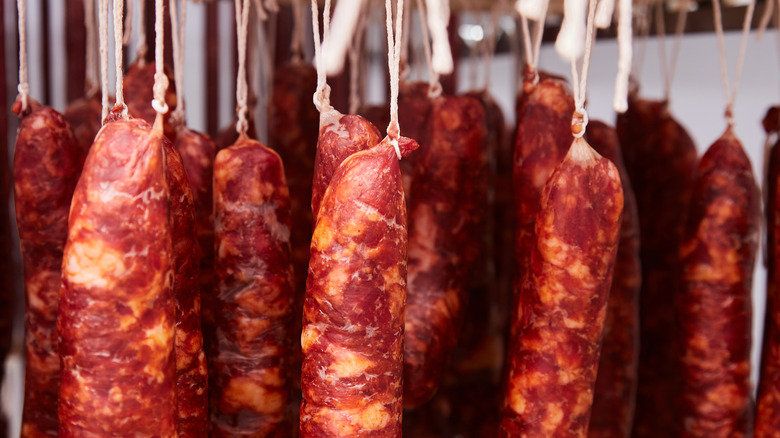Why You Might Be Confused Buying Pepperoni In Italy
In America, pepperoni is a popular snack and ingredient that can be found just about anywhere that sells meat. Butcher shops, grocery stores, and even gas stations sell versions of mouthwatering, spicy pepperoni. Pepperoni can be sold in a variety of forms, ranging from shelf-stable, bagged slices — perfect for throwing on homemade pizza — or fresh, chilled sausage logs — ideal for a charcuterie board.
Pepperoni in the U.S. typically is a "dried, cured, spiced sausage made from beef and pork," per The Spruce Eats. The meat used for pepperoni must have around a 70/30 blend, meaning the meat is 70% lean and 30% fat. This meat is ground and mixed with spices, including garlic powder, paprika, black pepper, fennel seed, and more (via Goldenage Cheese). The mixture is then stuffed into casings, fermented, smoked, and dried (The Spruce Eats).
However, when traveling in Italy, you'll want to avoid ordering pepperoni if you're craving a spicy cured meat.
Don't get lost in translation
According to Serious Eats, an order of "pepperoni" in Italy will actually result in sweet bell peppers being sent your way. Pepperoni is not a name for a type of meat in Italy, rather the similar version is called salame piccante.
Salame piccante is a "hard, fat-marbled salami," which is often made with pork, according to Serious Eats. It has a similar mixture of spices to American pepperoni, but also can include red peperoncino peppers, which is where the American name originates from (via Walks of Italy).
You can find salame piccante all across Italy, although it is most popular in the regions of Milan, Genoa, and Calabrese (via Zicasso). According to La Cucina Italiana, you can find salame piccante served sliced and as is — often alongside bread and cheese — or as a topping on a pasta dish. And, of course, you can also order it on pizza. Just make sure to get the name right.

